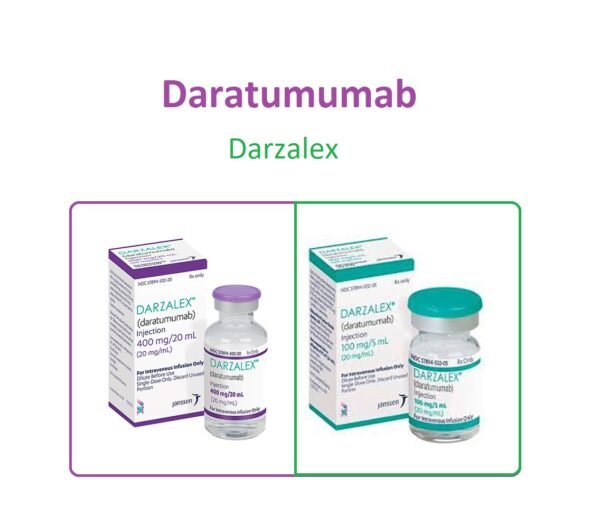Daratumumab is a monoclonal antibody that targets the CD38 protein found in high amounts on the surface of multiple myeloma cells. It is used for the treatment of multiple myeloma, a type of blood cancer that affects plasma cells. Daratumumab works by helping the immune system attack cancer cells. It is administered intravenously (IV).
Daratumumab (Darzalex) is a fully human monoclonal antibody of the IgG1k subtype that targets CD38 that are highly expressed in myeloma cells.
Daratumumab (Darzalex) Uses:
- Newly Diagnosed Multiple myeloma:
- Used in the treatment of newly diagnosed multiple myeloma (in combination with melphalan, bortezomib, and prednisone) in patients who are ineligible for autologous stem cell transplant.
- Relapsed or Refractory Multiple myeloma:
- Used in the treatment of multiple myeloma (in combination with dexamethasone and either bortezomib or lenalidomide ) in patients who have received at least one prior therapy.
- Used in the treatment of multiple myeloma (in combination with pomalidomide and dexamethasone) in patients who have received at least two prior therapies, including lenalidomide and a proteasome inhibitor.
- Used in the treatment of multiple myeloma (as monotherapy) in patients who have received at least 3 prior lines of therapy, including a proteasome inhibitor and an immunomodulatory agent or who are double refractory to a proteasome inhibitor and an immunomodulatory agent.
Daratumumab (Darzalex) Dose in Adults
Note:
- Before Each Treatment:
- Take some specific medicines 1 to 3 hours before your daratumumab infusion. These medicines will help prevent any reactions to the treatment.
- They include a type of medicine to reduce inflammation (corticosteroid), a medicine to reduce fever (antipyretic), and another one to prevent allergies (antihistamine).
- After Each Treatment:
- Take a medicine that helps reduce inflammation (corticosteroid). This will help you avoid any delayed reactions to the treatment.
- Herpes Zoster (a type of virus) Precaution:
- Start taking a medicine to prevent herpes zoster (a viral infection) within a week of starting daratumumab. Keep taking it for 3 months after you finish the treatment.
- How Much to Take:
- The amount of daratumumab you get is based on your weight.
- On the first week, if the full dose is too much at once, you can split it over 2 days.
Daratumumab (Darzalex) Dose in the treatment of newly diagnosed Multiple myeloma: IV:
If you're using daratumumab with other medicines (like bortezomib, melphalan, and prednisone):
- Weeks 1-6: Take daratumumab once a week.
- Weeks 7-54: Take daratumumab once every 3 weeks.
- Weeks 55 and later: Take daratumumab once every 4 weeks. Continue this until the doctor says the disease is getting worse.
For all the times above, the amount of daratumumab you get is the same: 16 mg for every kg of your body weight.
Remember to also follow the instructions for the other medicines you're taking with daratumumab.
Daratumumab (Darzalex) Dose in the treatment of relapsed or refractory Multiple myeloma: IV:
For all the treatments, the amount of daratumumab you get depends on your weight: 16 mg for every kg of your body weight.
If You're Only Taking Daratumumab (Monotherapy):
- Weeks 1-8: Take it once a week.
- Weeks 9-24: Take it every 2 weeks.
- Weeks 25 and later: Take it once a month until the doctor says the disease is getting worse.
If Taking Daratumumab with Lenalidomide & Low-Dose Dexamethasone:
- Follow the same schedule as the monotherapy above.
If Taking Daratumumab with Pomalidomide & Low-Dose Dexamethasone:
- Again, follow the same schedule as the monotherapy.
If Taking Daratumumab with Bortezomib & Dexamethasone:
- Weeks 1-9: Take it once a week.
- Weeks 10-24: Take it every 3 weeks.
- Weeks 25 and later: Take it once a month until the disease gets worse.
If You Miss a Dose:
- Take it as soon as you can and then adjust the next doses accordingly.
Before Each Treatment (Premedication’s):
- 1-3 hours before your treatment, take:
- A corticosteroid: The type and amount depend on whether you're on monotherapy or combination therapy.
- A fever-reducing pill: Acetaminophen (650 to 1,000 mg).
- An allergy pill: Diphenhydramine (25 to 50 mg) or something similar.
There's also another set of pre-treatment medicines some people take which include a few other things.
After Each Treatment (Post-infusion medication):
- Take a corticosteroid. The type and amount depend on whether you're on monotherapy or combination therapy.
- If you have lung problems, you might also need some inhaler medicines for a while.
Use in Children:
Not indicated.
Daratumumab (Darzalex) Pregnancy Risk Category: D
- We don't have studies on how daratumumab affects pregnancies.
- Daratumumab is a type of drug called a monoclonal antibody. These drugs can go across the placenta and reach the baby.
- Based on how it works, daratumumab might reduce some types of cells and bone density in a growing baby.
- Women who could become pregnant should use reliable birth control during treatment and for 3 months after finishing.
- If a baby was exposed to daratumumab while in the womb, they shouldn't get live vaccines right after birth. Wait until doctors check the baby's blood first.
Use of Daratumumab while breastfeeding
- We aren't sure if daratumumab gets into breast milk.
- Daratumumab is a type of drug called a monoclonal antibody. These drugs can be found in breast milk, but they usually don't get into the baby's system in large amounts.
- If you're thinking about breastfeeding while taking this drug, consider the potential risks to your baby and the benefits of the medicine for you.
Daratumumab (Darzalex) Dose in Kidney Disease:
- If your kidneys clear out (CrCl) between 15 to 89 mL of fluid a minute, the manufacturer hasn't given any special dose changes.
- Also, having a CrCl in this range doesn't seem to change how daratumumab works in your body.
Daratumumab (Darzalex) Dose in Liver disease:
- Mild or Moderate Liver Issues:
- If your total bilirubin (a liver test) is up to 3 times the normal upper limit, or if your AST (another liver test) is high, the manufacturer doesn't suggest any dose changes for daratumumab.
- In simpler terms, if you have mild or moderate liver issues, daratumumab is expected to work as usual, and no dose change is needed.
- Severe Liver Issues:
- If your total bilirubin is more than 3 times the normal upper limit, the manufacturer hasn't provided any specific dosing advice because it hasn't been studied.
Common Side Effects of Daratumumab (Darzalex):
- Central Nervous System:
- Fatigue
- Headache
- Gastrointestinal:
- Constipation
- Decreased Appetite
- Vomiting
- Nausea
- Diarrhea
- Hematologic & Oncologic:
- Lymphocytopenia
- Anemia
- Neutropenia
- Thrombocytopenia
- Neuromuscular & Skeletal:
- Arthralgia
- Limb Pain
- Musculoskeletal Chest Pain
- Back Pain
- Respiratory:
- Cough
- Upper Respiratory Tract Infection
- Pneumonia
- Nasal Congestion
- Dyspnea
- Nasopharyngitis
- Miscellaneous:
- Infusion Related Reaction
- Fever
Less Common Side Effects Of Daratumumab (Darzalex):
- Cardiovascular:
- Hypertension
- Central Nervous System:
- Chills
- Infection:
- Herpes Zoster Infection
- Miscellaneous:
- Physical Health Deterioration
Contraindication to Daratumumab (Darzalex):
If you've had a severe allergic reaction (like a life-threatening one) to daratumumab or any part of the medicine, you shouldn't take it.
Warnings and precautions
Suppression of bone marrow
- When daratumumab is used with other cancer drugs for treating multiple myeloma, it can lower certain blood cells even more, like neutrophils (which fight infections) and platelets (which help blood clot).
- In research studies, many people had lower levels of different blood cells, including some serious cases.
- Watch out for signs of infections or bleeding.
- Doctors will regularly check blood levels. If they're too low, they might delay the daratumumab treatment to let the blood cells recover.
- In some cases, you might need additional treatments, like growth boosters for blood cells or platelet transfusions.
Infusion reactions
- Some patients might have strong or severe reactions when getting daratumumab, especially during the first time. These reactions can include breathing problems, allergic reactions, throat irritation, and high blood pressure, among others.
- Common signs of these reactions include coughing, feeling cold, vomiting, and nausea. Some patients might also feel itchy, get a fever, or have low blood pressure.
- About half of the patients in studies had these reactions. Most reactions were mild or moderate.
- Reactions usually happen during the treatment or within 4 hours after it's done. However, some reactions can show up to 2 days later.
- To help prevent these reactions, patients are given other medicines before getting daratumumab. In some cases, even more medicines are added to this pre-treatment to help.
- If a patient has a mild, moderate, or severe reaction, the infusion might be slowed down. If there's a very severe or life-threatening reaction, the treatment is stopped for good, and the patient gets emergency care.
- Treatments should be done in places where emergency care is easily available, just in case.
- After the treatment, patients should also take a type of steroid to reduce the chance of later reactions. People with specific lung issues should be watched more closely and might get inhalers.
Interference with determination of myeloma response
- Daratumumab is a specific kind of antibody (human IgG kappa).
- When doctors test the blood to monitor myeloma, they look for certain proteins using tests like serum protein electrophoresis and immunofixation assays.
- Daratumumab can show up in these tests and can be confused with the proteins doctors are looking for (endogenous M-protein).
- This means, in some patients, the presence of daratumumab might make it tricky to tell if the myeloma is getting better or worse, especially for those with a specific type of myeloma protein (IgG kappa).
Daratumumab: Drug Interaction
Note: Drug Interaction Categories:
- Risk Factor C: Monitor When Using Combination
- Risk Factor D: Consider Treatment Modification
- Risk Factor X: Avoid Concomitant Use
|
Risk Factor C (Monitor therapy). |
|
|
Chloramphenicol Ophthalmic |
May increase the toxic/adverse effects of Myelosuppressive Agents. |
|
CloZAPine |
CloZAPine's toxic/adverse effects may be exacerbated by myelosuppressive agents. Particularly, there may be an increase in the risk of neutropenia. |
|
Promazine |
May increase the myelosuppressive effects of myelosuppressive agents. |
|
Risk Factor X (Avoid Combination) |
|
|
BCG (Intravesical). |
Myelosuppressive agents may reduce the therapeutic effects of BCG (Intravesical). |
|
Cladribine |
May increase the myelosuppressive effects of Myelosuppressive Drugs. |
|
Deferiprone may have a neutropenic effect that myelosuppressive agents can increase. |
|
|
Dipyrone |
Might increase the toxic/adverse effects of Myelosuppressive Agents. In particular, there may be an increase in the risk of pancytopenia and agranulocytosis. |
Monitoring parameters:
- Blood Tests:
- Check complete blood cell counts regularly.
- Determine blood type before starting the treatment.
- Reactions:
- Watch for signs of a severe allergic (anaphylactic) reaction.
- Be alert for infusion reactions (problems that happen during or shortly after the medicine is given).
- Other Symptoms:
- Look out for signs of infections.
- Notice any signs of bleeding.
Using Faster Infusion Rate (off-label method):
- Vital Signs:
- Check vital signs:
- Before starting the infusion.
- Every 15 minutes during the first hour.
- At the end of the infusion.
- Check vital signs:
- After Infusion:
- Watch patients for 30 minutes after the fast infusion to make sure no infusion reactions occur.
How to administer Daratumumab (Darzalex)?
General Instructions:
- Give it through IV infusion, not as a quick push or bolus.
- Always give the premedications 1 to 3 hours before daratumumab.
- Only give in places ready to handle any infusion reactions.
- Use the right infusion equipment as specified.
- Don’t mix or give with other medicines.
Infusion Preparation:
- If it's been in the fridge, start the infusion as soon as it reaches room temperature.
- Finish the infusion within 15 hours.
- If there's any issue and infusion can’t be finished, don’t save or reuse what's left.
Infusion Reactions:
- Stop the infusion if any reactions occur.
- If the reaction goes away, you can continue the infusion.
- After the infusion, give an oral corticosteroid to reduce any late reactions.
- If the patient has lung issues, consider giving specific inhalers after the infusion.
Infusion Rate Guide:
- Week 1 Infusion:
- Start at 50 mL/hour.
- If no reactions, increase by 50 mL/hour every hour until 200 mL/hour.
- Week 2 Infusion:
- Use 500 mL only if no reactions during the previous infusion.
- Start rate same as week 1.
- Subsequent Infusions (from week 3):
- Start at 100 mL/hour.
- Increase rate similar to previous weeks if no reactions.
Faster Infusion Rate (off-label method):
- This method was tested in a small study.
- Split the dose: 20% given over 30 minutes, then 80% over 60 minutes.
- Keep the usual premedications.
- Monitor vital signs frequently.
- Observe patients for any reactions for 30 minutes after infusion.
- Before using this faster method, ensure the patient has tolerated the standard infusion.
Mechanism of action of Daratumumab (Darzalex):
- Daratumumab is a type of human antibody.
- It targets a protein called CD38, which is found on the surface of myeloma cells (a type of cancer cell).
- CD38 is not typically found at high levels on normal immune cells.
- Daratumumab works by:
- Causing the cancer cells to die directly.
- Enlisting the immune system to attack and kill the cancer cells through various mechanisms like:
- Activating immune cells to destroy the cancer cells.
- Encouraging the immune system to "eat up" the cancer cells.
- Promoting the use of complement proteins to kill the cancer cells.
So, daratumumab helps fight cancer by targeting the CD38 protein on myeloma cells and activating the immune system to destroy them.
How Daratumumab Spreads in the Body (Distribution):
- When given alone (Monotherapy): The drug spreads to about 4.7 liters of body fluid.
- When given with other drugs (Combination therapy): It spreads to about 4.4 liters of body fluid.
How Long Daratumumab Stays in the Body (Half-life):
- When given alone (Monotherapy): It takes about 18 days for half of the drug to be eliminated from the body.
- When given with other drugs (Combination therapy): It takes about 22 to 23 days for half of the drug to be eliminated.
International Brand Names of Daratumumab:
- Darzalex
Daratumumab Brand Names in Pakistan:
Not available.




 Injection.webp)